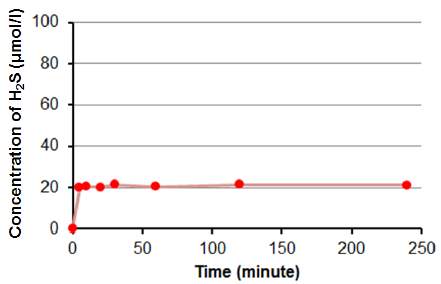General Information
It has been recognized that hydrogen sulfi de (H2S) has an important role as a physicological active substance for vasodilation, cytoprotection, modulation of insulin secretion. Although H2S is considered as a gaseous molecule such as NO and CO, about 80% of the total sulfi de exists as hydrogen sulfi de anion (HS-) under physiological condition. In addition, H2S easily converts to various biochemical molecules such as persulfi des and polysulfi des, which react with sulfhydryl moieties in a living body. Therefore, the precise action mechanism of H2S has not been cleared.
Sodium sulfi de (Na2S) and sodium hydrogen sulfi de (NaHS) have been widely used as a H2S donor. Only instantaneously release of H2S from Na2S and NaHS, however, is available in aqueous solution, and threse reagents give a transient stimulation of H2S.
GYY4137 is a slow-releasing hydrogen sulfi de donor developed by P. K. Moore et al.1). Since GYY4137 is water-soluble and continuously releases H2S by hydrolysis in a neutral aqueous solution, it is reported that GYY4137 shows distinct cellular effects such as anti-hypertensive, anti-atherosclerotic, and anti-tumor activities 2-5).

Fig. 1 H2S release of GYY4137 by hydrolysis
Contents
| -SulfoBiotics- GYY4137 | 10 mg x 1 |
Storage Condition
Store at 0-5°C
Precaution
- This reagent releases a toxic hydrogen sulfi de gas in a neutral aqueous solution.
- Refer to the material safety data sheet before using the reagent.
General Protocol
- Dissolve 3.8 mg of GYY4137 with 0.5 ml of ddH2O to prepare 20 mmol/l GYY4137 Stock Solution.
- Store the stock solution at -20°C and use within two months. Aliquot the solution for longer storage.
- Dilute the 20 mmol/l GYY4137 Stock Solution to an appropriate concentration depending on your experiment.
- H2S release is initiated by addition of the stock solution to neutral buffers or culture medium.
Experimental Example
H2S release profi le of GYY4137 in PBS
-
- Ten microliter (10 µl) of 20 mmol/l GYY4137 Stock Solution was added to 2 ml of PBS to prepare 100 !mol/l GYY4137 (PBS) solution.
Then, the solution was incubated at room temperature with sealing. - The yielded hydrogen sulfi de anion was quantifi ed at each time by methylene blue method.
H2S release from GYY4137 in PBS was slow and sustained.
- Ten microliter (10 µl) of 20 mmol/l GYY4137 Stock Solution was added to 2 ml of PBS to prepare 100 !mol/l GYY4137 (PBS) solution.
-

Fig. 2 H2S release profi le of 100 !mol/l GYY4137 in PBS
Reference
- L. Li, M. Whiteman, Y. Y. Guan, K. L. Neo, Y. Cheng, S. W. Lee, Y. Zhao, R. Baskar, C-H. Tan, and P. K. Moore, "Characterization of a Novel, Water-Soluble Hydrogen Sulfide-Releasing Molecule (GYY4137): New Insights Into the Biology of Hydrogen Sulfide", Circulation, 2008, 117, 2351.
- M. Whiteman, L. Li, P. Rose, C-H. Tan, D. B. Parkinson, and P. K. Moore, "The Effect of Hydrogen Sulfide Donors of Lipopolysaccharide-Induced Formation of Inflammatory Mediators in Macrophages", Antioxid. Redox Signal., 2013, 19, 1749.
- Z. W. Lee, J. Zhou, C-S. Chen, Y. Zhao, C-H. Tan, L. Li, P. K. Moore, and L-W. Deng, "The Slow-Releasing Hydrogen Sulfide Donor, GYY4137, Exhibits Novel Anti-Cancer Effects In Vitro and In Vivo", PLos One, 2011, 6, e21077.
- L. Li, B. Fox, J. Keeble, M. Salto-Tellez, P. G. Winyard, M. E. Wood, P. K. Moore, and M. Whiteman, "The complex effects of the slow-releasing hydrogen sulfide donor GYY4137 in a model of acute joint inflammation and in human cartilage cells", J. Cell. Mol. Med., 2013, 17, 365.
- Z. Liu, Y. Han, L. Li, G. Meng, X. Li, M. Shirhan, M. T. Peh, L. Xie, S. Zhou, X. Wang, Q. Chen, W. Dai, C-H. Tan, S. Pan, P. K. Moore and Y. Ji, "The hydrogen sulfide donor, GYY4137, exhibits anti-atherosclerotic activity in high fat fed apolipoprotein E-/- mice", Br. J. Pharmacology, 2013, 169, 1795.
Frequently Asked Questions / Reference
SB06: -SulfoBiotics- GYY4137
Revised Apr., 05, 2024


 Hidden sections will not be printed.
Hidden sections will not be printed.